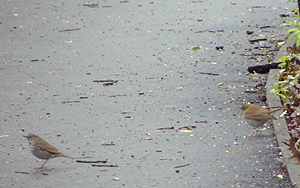 Spring migration has hit NYC hard, like a horde of bloodthirsty barbarians rampaging across the boroughs, except that the barbarians are actually exquisite songbirds that are thirsty for insects and seeds rather than blood. Yes, that metaphor is extremely awkward but my original one, a bird bomb exploding in Manhattan, seemed in poor taste. Suffice to say, warblers have arrived at last.
Spring migration has hit NYC hard, like a horde of bloodthirsty barbarians rampaging across the boroughs, except that the barbarians are actually exquisite songbirds that are thirsty for insects and seeds rather than blood. Yes, that metaphor is extremely awkward but my original one, a bird bomb exploding in Manhattan, seemed in poor taste. Suffice to say, warblers have arrived at last.
Of course, Central Park is spring migration central. The local birding boards have been buzzing with reports of phenomenal passerines, each one more exciting than the last. Once the New York warbler count passed 15 different species, we knew that the moment was upon us. The Core Team was ready to bird Central Park.
Despite the rain and gloom yesterday morning, we were committed to picking up at least one new warbler, a type of bird that we are woefully inexperienced with. We plotted a course based on data from the NYC Bird Report that took us around Turtle Pond to Belvedere Castle, through the Ramble, to the Lake and then back again. This, we hoped, would give us a shot at many of the current rarities. As Mason slumbered, we birded.
All of the usuals were in attendance, the Rock Pigeon and Mourning Dove, the European Starling and American Robin, the House Sparrow and the Northern Cardinal, the American Crow and Red-tailed Hawk, the Common Grackle, Mallard, Mute Swan, Canada Goose, and Double-crested Cormorant. But we were there for warblers, and warblers we saw. The most common warbler of the day was the Yellow-rumped Warbler. When yellow-rumps make the scene, they make it in a big way; we saw tons of these sharp songbirds. We also spotted a number of Black-and-white Warbler and Yellow Warbler, two very different looking birds, as well as a single Northern Waterthrush. Our only other warbler was, fortunately, the one we came for, the Palm Warbler. The palm warbler is a beautiful little bird, yellow in the way that most wood-warblers are, with a saucy rufous cap and streaks on its breast. These warblers have been living it up in midtown for the last couple of weeks but are near the end of their visit, so we’re very pleased to have had the chance to meet Dendroica palmarum and add it to our list.
Plenty of tiny drab songbirds eluded identification, but the day’s festivities hardly ended at warblers. We spotted familiar friends like the Red-winged Blackbird, White-throated Sparrow, House Finch, and our first Gray Catbird of the year. The budding trees also offered Tufted Titmouse, Ruby-crowned Kinglet, Eastern Phoebe, and Downy Woodpecker. In the reeds grazed Green Heron and Great Egret, while a variety of swallows (Tree, Barn, and Northern Rough-winged) worked the surface of the water. Chimney Swift also made an appearance.
Though our eyes were raised most of the time to the canopy, we did search the underbrush every so often for ground birds. The rewards for our efforts were a House Wren and a pair of thrushes. The picture above actually captures a special moment, two different types of thrushes side by side. The handsome fellow on the left is a Hermit Thrush, easily identified by his olive-brown back, rusty tail, and dark-spotted breast. Central Park is home to many a hermit. The thrush on the right is roughly the same size as Catharus guttatus, but has cinnamon upperparts and a creamy breast with faint spotting. This splendid bird is our very first Veery. Catharus fuscescens is an evasive bird, one that I had actually stopped looking for. Thankfully, Sara spotted it for both of us, solid evidence that birding is better when you’re part of a team.











Leave a Comment